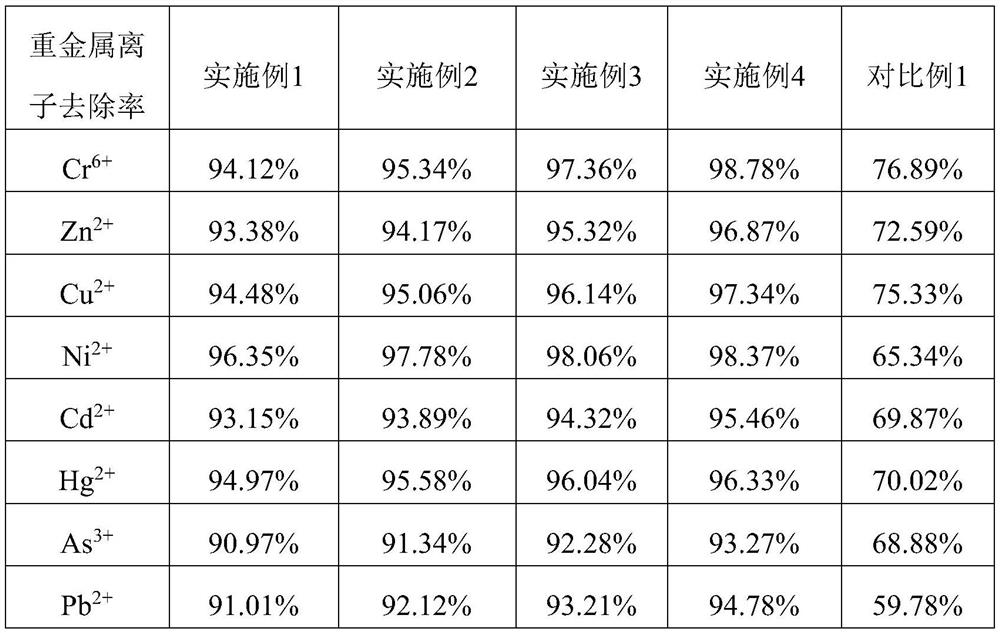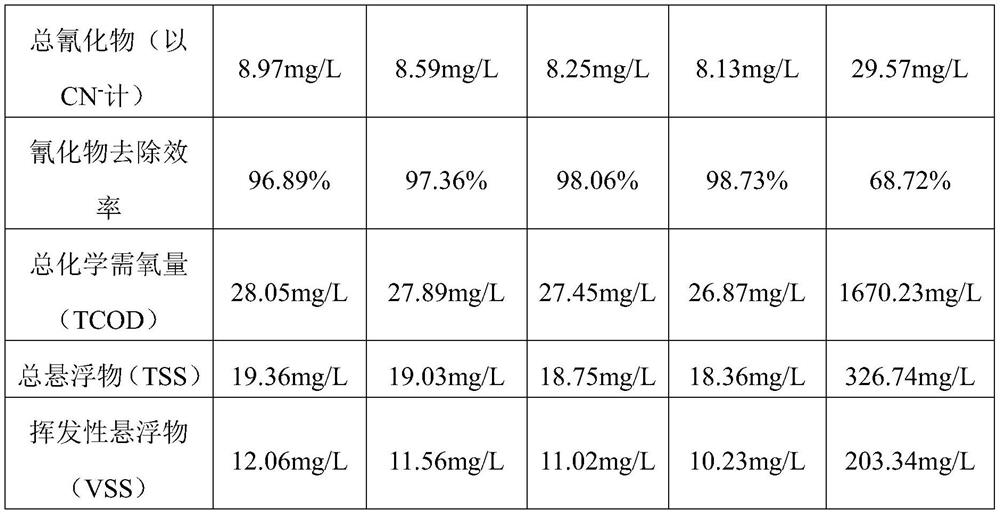A magnetic composite-cyanide decomposing enzyme composite nanoparticle, its preparation method and application, and its method for treating electroplating wastewater
A composite nanoparticle and nanoparticle technology, which is applied in the field of electroplating sewage treatment, can solve the problems of increased treatment cost, single dye, and impact on agricultural production, and achieve good regeneration ability, increased specific surface area, and good magnetic adsorption ability.
- Summary
- Abstract
- Description
- Claims
- Application Information
AI Technical Summary
Problems solved by technology
Method used
Image
Examples
Embodiment 1
[0071] A magnetic composite-cyanide decomposing enzyme composite nanoparticle provided in this embodiment, by weight component, includes the following components:
[0072] Spinel CdZn 2 o 4 30 parts of ferromagnetic nanoparticles;
[0073] Magnetic Fe 3 o 4 30 parts of nanoparticles;
[0074] SiO 2 15 parts of nanoparticles;
[0075] 50 parts of nitrilase;
[0076] 20 parts of glycidyl methacrylate;
[0077] 20 parts of N-(isobutoxymethyl)acrylamide;
[0078] 5 parts of 3-glycidylpropyltrimethoxysilane;
[0079] 5 parts of polyethyleneimine;
[0080] Adenosine 5'-monophosphate disodium salt 2 parts;
[0081] 1 part of N-2-hydroxyethylpiperazine-N'-2-ethanesulfonic acid;
[0082] 0.5 parts of p-nitrophenyl palmitate;
[0083] Fe 2 (SO 4 ) 3 9H 2 O 30 copies;
[0084] Cu(SO 4 ) 2 ·6H 2 O 30 copies;
[0085] 5 parts of initiator 2,2'-azobis(2-methylpropionitrile);
[0086] 4 parts of crosslinking agent diethylenetriamine.
[0087] Among them, spinel CdZn ...
Embodiment 2
[0115] A magnetic composite-cyanide decomposing enzyme composite nanoparticle provided in this embodiment, by weight component, includes the following components:
[0116] Spinel CuCr 2 o 4 35 parts of ferromagnetic nanoparticles;
[0117] Magnetic α-Fe 2 o 3 35 parts of nanoparticles;
[0118] SiO 2 17.5 parts of nanoparticles;
[0119] 55 parts of rhodanase;
[0120] 25 parts of polylactic acid;
[0121] 25 parts of N,N'-methylenebisacrylamide;
[0122] 7.5 parts of 3-mercaptopropyltrimethoxysilane;
[0123] For spinel CuCr 2 o 4 7.5 parts of tris (2-aminoethyl) amines modified by ferromagnetic nanoparticles amino group;
[0124] 3 parts of cytidine 5'-monophosphate disodium salt;
[0125] 1.5 parts of N-2-hydroxyethylpiperazine-N'-2-ethanesulfonic acid;
[0126] 0.75 parts of p-nitrophenyl palmitate;
[0127] Ni(CH 3 COO) 2 4H 2 O 35 copies;
[0128] Mg(CH 3 COO) 2 4H 2 O 35 copies;
[0129] 6.5 parts of initiator 2,2'-azobis[2-(2-imidazolin-2-yl)prop...
Embodiment 3
[0159] A magnetic composite-cyanide decomposing enzyme composite nanoparticle provided in this embodiment, by weight component, includes the following components:
[0160] Spinel CoMn 2 o 4 37 parts of ferromagnetic nanoparticles;
[0161] Magnetic γ-Fe 2 o 3 37 parts of nanoparticles;
[0162] SiO 2 18.5 parts of nanoparticles;
[0163] β-mercaptopyruvate sulfur transferase 58 parts;
[0164] 27.5 parts of polyvinyl alcohol;
[0165] 27.5 parts of polyacrylamide;
[0166] 4.5 parts of γ-methacryloxypropyltrimethoxysilane, 4 parts of γ-(2.3 glycidoxy)propyltrimethoxysilane;
[0167] For spinel CoMn 2 o 4 8.5 parts of 2,2-(ethylenedioxy)bis(ethylamine) modified by ferromagnetic nanoparticles amino group;
[0168] 3.8 parts of guanosine 5'-monophosphate disodium salt;
[0169] 1.8 parts of N-2-hydroxyethylpiperazine-N'-2-ethanesulfonic acid;
[0170] 0.85 parts of p-nitrophenyl palmitate;
[0171] Al(NO 3 )3 ·6H 2 O 37.5 parts;
[0172] Zn(NO 3 ) 2 ·6H 2 O 3...
PUM
| Property | Measurement | Unit |
|---|---|---|
| quality score | aaaaa | aaaaa |
| quality score | aaaaa | aaaaa |
| quality score | aaaaa | aaaaa |
Abstract
Description
Claims
Application Information
 Login to View More
Login to View More - R&D
- Intellectual Property
- Life Sciences
- Materials
- Tech Scout
- Unparalleled Data Quality
- Higher Quality Content
- 60% Fewer Hallucinations
Browse by: Latest US Patents, China's latest patents, Technical Efficacy Thesaurus, Application Domain, Technology Topic, Popular Technical Reports.
© 2025 PatSnap. All rights reserved.Legal|Privacy policy|Modern Slavery Act Transparency Statement|Sitemap|About US| Contact US: help@patsnap.com



